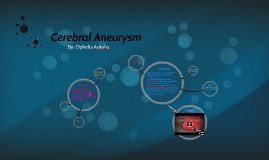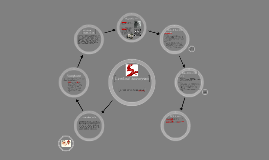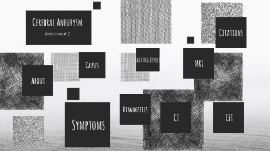Cerebral Aneurysm
Transcript: By: Nick Barry & Daniel Pageau Other Risks Risks & Benefits M.R.A. could damage blood vessels because it passes through them so, in the heart it is possible to provoke a stroke or heart attack which can lead to death pregnant women should inquire about the risks to their unborn baby Unruptured-Symptoms of an unruptured aneurysm include pain above and behind the eye, dilated pupil, change in vision double vision, numbness, weakness or paralysis on one side of the face, and/or a drooping eyelid. If you experience any of these symptoms you should contact your healthcare professional. A cerebral aneurysm specifically affects the tissue of the brain and tissues of the arteries inside the brain. Due to the fact that the aneurysm is leaking blood inside your brain it causes irritation and pressure inside the skull. This pressure restricts blood flow and causes damage to structures inside the brain. "What Are the Risks of MRI Scans?" Risks of an MRI or MRA Scan? © 2009-2011 P. Griffith Creative, LLC., n.d. Web. 10 Nov. 2013. <http://www.two-views.com/MRI/Risks.html>. References Benefits - eliminate the need for surgery present a very detailed, clear and accurate picture of the blood vessels makes it possible to assess vessels in several specific areas Benefits - The test is not painful and you cannot feel it the procedure can be repeated without problems Because radiation is not used Diagnostic Tests The effects on quality of life due to a ruptured aneurysm are extensive. 30 to 40 percent of ruptures result in death, 25 to 35 percent result in moderate to severe brain damage, and 15 to 30 percent experience only mild difficulties or almost none. The brain damage received from the bleeding aneurysm can leave you with extreme mental and physical deficits, such as loss of vision, paralysis or numbness in a limb, trouble speaking or understanding a language, and seizures. Angiography - a dye test used to analyze the arteries or veins If you have problems with your kidneys, you could develop a severe reaction This reaction can affect tissues throughout the body, e.x. (skin, joints, liver and lungs.) If you have a history of kidney disease M.R.I. and M.R.A. are not suggested M.R.A. Ruptured-Symptoms of a ruptured aneurysm include sudden extremely severe headache, nausea and vomiting, stiff neck, blurred or double vision, sensitivity to light, seizure, a drooping eyelid, loss of consciousness, and/or confusion. Specialized cells Risks - anxiety and claustrophobia can be felt when entering the scanner kidneys could develop a severe reaction after receiving the MRI contrast dye that is used to make blood vessels more visible M.R.A. (magnetic resonance angiography) - produces detailed images of blood vessels (painless and noninvasive,) can show size and shape of an unruptured aneurysm Cerebral Aneurysm Risks & Benefits Angioraphy - Risks - there is a risk to a fetus in the first 12 weeks of a woman’s pregnancy the magnet used may affect pacemakers, artificial limbs, and other medical devices that contain iron foreign metal materials could distort the M.R.A.'s images Angiography "Benefits and Risks of Coronary Angiogram Procedure?" Benefits and Risks of Coronary Angiogram Procedure? Angeles Health International Inc 2011, n.d. Web. 10 Nov. 2013. <http://www.angeleshealth.com/angiogram/benefits-and-risks-coronary-angiogram-procedure>. There are different symptoms for each stage of this disease. The stages are as follow: http://www.strokeassociation.org/STROKEORG/AboutStroke/TypesofStroke/HemorrhagicBleeds/What-You-Should-Know-About-Cerebral-Aneurysms_UCM_310103_Article.jsp Effects on Quality of Life "Magnetic Resonance Angiography (MRA)." Johns Hopkins Medicine, Based in Baltimore, Maryland. The Johns Hopkins Hospital and Johns Hopkins Health System, n.d. Web. 10 Nov. 2013. <http://www.hopkinsmedicine.org/healthlibrary/test_procedures/cardiovascular/magnetic_resonance_angiography_mra_135,14/>. Other Risks Symptoms

















